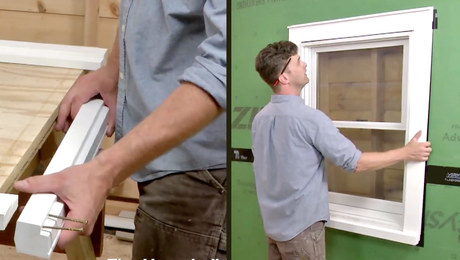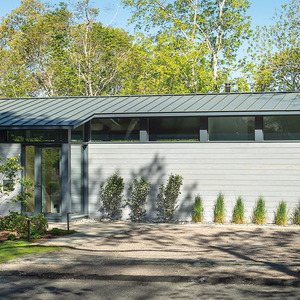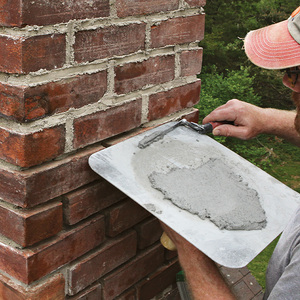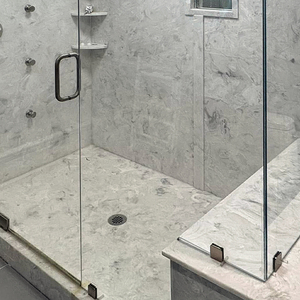*
I’m preparing to break through an exterior wall to add an addition. It’s an exterior wall on the first floor of a two story house. Clearly it’s a bearing wall. It bears the second story wall above and the roof. I’ll need to bury the new beam in the wall above, so the ceiling of the existing room and the ceiling of the new room will be in the same plane. The beam will be substantially taller than the joists which will need to hang on the new beam. I realize that substantial temporary support will be needed and that the lower edge of the new beam will rest on the top plates of the adjoining (reinforced) walls, but I’m not sure of how to connect the shortened second floor studs into the beam. What I’m really after is some reading on the subject. Something simiar to what’s in this month’s FHB, but with more focus on opening the wall for an addition rather than for a door. Does anyone know of a past article or a book?
Discussion Forum
Discussion Forum
Up Next
Video Shorts
Featured Story

Whether it’s already in your house or picked up at a flea market, vintage hardware almost always needs help.
Featured Video
How to Install Exterior Window TrimHighlights
"I have learned so much thanks to the searchable articles on the FHB website. I can confidently say that I expect to be a life-long subscriber." - M.K.
Fine Homebuilding Magazine
- Home Group
- Antique Trader
- Arts & Crafts Homes
- Bank Note Reporter
- Cabin Life
- Cuisine at Home
- Fine Gardening
- Fine Woodworking
- Green Building Advisor
- Garden Gate
- Horticulture
- Keep Craft Alive
- Log Home Living
- Military Trader/Vehicles
- Numismatic News
- Numismaster
- Old Cars Weekly
- Old House Journal
- Period Homes
- Popular Woodworking
- Script
- ShopNotes
- Sports Collectors Digest
- Threads
- Timber Home Living
- Traditional Building
- Woodsmith
- World Coin News
- Writer's Digest


















Replies
*
Charles,
View Image
© 1999-2000
"The first step towards vice is to shroud innocent actions in mystery, and whoever likes to conceal something sooner or later has reason to conceal it."
Aristotle
*Charles:Sorry, I don't have an answer for you but here's something else to consider:You say that you intend to reinforce the walls that will bear the ends of this new beam. What about the foundation below? You may be creating point loads at the foundation that require reinforcing all the way down to the soil.
*That's an excellent point. It's concrete block, so I think it will be able to carry the load, but your comment points out my need to study up on this before proceeding!
*You know it's going to come down to the 'E' word...
*Hi Charles, Is the addition built yet? The cart may be before the horse. Must those ceilings be co-planer? You may require the services of an architect. Or even a carpenter! We need to to know where your at on this project. Regards, Dan-O
*Nothing started yet. Purely in the planning phase. The ceilings need to be co-planar as the addition will extend the existing room. While searching for a carpenter, I'm trying to get knowledgable enough to ask some intelligent questions. Hard finding someone to take on this kind of work when there's so much more rewarding work available, so I'm also trying to determine if I can take it on myself if I can't find anyone.
*Charles, A remodeling job is best undertaken with a plan. The work is rewarding. Hire an architect or a builder. Good luck..
*Charles,Don't want to sound blunt, but you need more than just reading material. What you are proposing to do will take some skill and ingenuity. If you never tackled something like this before ( and from your posting, you have'nt), you would be much better off hiring a carpenter/contractor who has actually done this sort of thing before. Don't risk a building collapse by trying something of this magnetude by yourself.If you have a City or County Engineer or Building Inspector where you live, consult with them about who they would recommend for such a job.Davo.
*How wide is the opening going to be? It makes a world of difference on just how many upper floor studs are to be affected....Sounds like a lot of extra work and money doing it this way. A header beam would be much easier...maybe a nice set of French doors? Sometimes it's good to design something with the "difficulty" factor thrown in, especially if your doing it yourself. It's always amazed me how well a house holds itself together, but if you remove too much you could cause a collapse. http://www.jjwalters.com
*Charles:Don't be put off by those who tell you you're not smart enough to do it. There is a first time for everything. If you have the confidence to try (and yes, to deal with repairing any mistakes) I say try, assuming this is on your own house and your insurance is valid. I built my first house (no insurance) in my early 20's with only books and childhood experiences from parents and it is still standing, but also did experience the "first time" for 150 stitches at once. There are literally hundreds of library books, a good starting point is a simple old classic structural text -- "Elements of Strength of Materials", Timoshenko and Young, Van Nostrand. To paraphrase Matt (#2) -- start at the ground up, even below ground.
*
I'm preparing to break through an exterior wall to add an addition. It's an exterior wall on the first floor of a two story house. Clearly it's a bearing wall. It bears the second story wall above and the roof. I'll need to bury the new beam in the wall above, so the ceiling of the existing room and the ceiling of the new room will be in the same plane. The beam will be substantially taller than the joists which will need to hang on the new beam. I realize that substantial temporary support will be needed and that the lower edge of the new beam will rest on the top plates of the adjoining (reinforced) walls, but I'm not sure of how to connect the shortened second floor studs into the beam. What I'm really after is some reading on the subject. Something simiar to what's in this month's FHB, but with more focus on opening the wall for an addition rather than for a door. Does anyone know of a past article or a book?